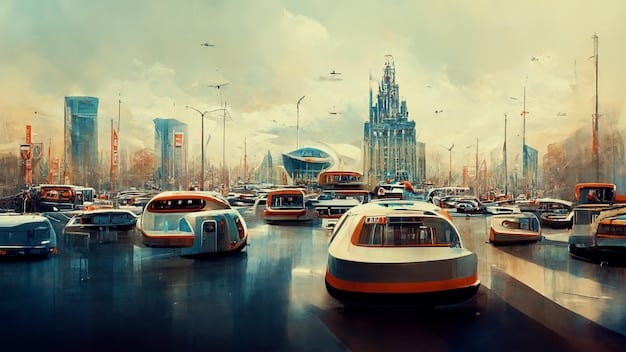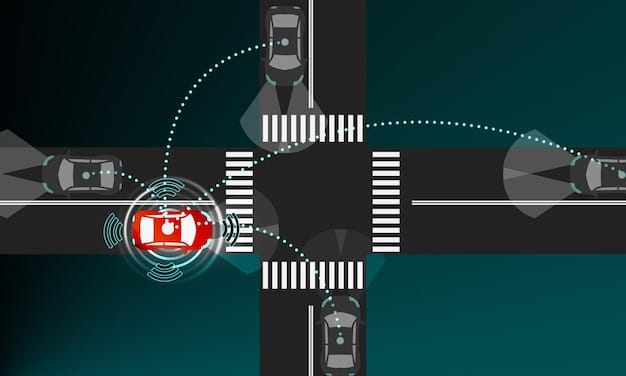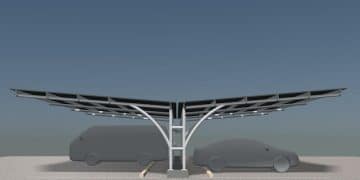The Future of Autonomous Driving: Navigating Setbacks and Charting the Road Ahead

The Future of Autonomous Driving: What’s Next After Recent Setbacks? explores the challenges, advancements, and realistic timelines for self-driving vehicles, examining technological hurdles, regulatory landscapes, and public perception shaping the industry’s trajectory.
The dream of fully autonomous driving has encountered speed bumps, raising questions about its immediate future. Recent setbacks have prompted a reassessment of timelines and strategies, but innovation continues to push the boundaries. What lies ahead after these disruptions?
The Current State of Autonomous Driving Technology
Autonomous driving technology has made significant strides, yet it’s not without its limitations. Despite advancements in sensor technology, AI algorithms, and computing power, fully autonomous vehicles still face challenges in unpredictable real-world conditions.
Levels of Automation
The Society of Automotive Engineers (SAE) defines six levels of driving automation, from 0 (no automation) to 5 (full automation). Currently, most commercially available vehicles offer Level 2 or Level 3 automation, requiring human intervention under certain circumstances.
Key Technologies
Several key technologies power autonomous vehicles, including:
- Lidar: Light Detection and Ranging, used for creating precise 3D maps of the environment.
- Radar: Radio Detection and Ranging, effective in various weather conditions for detecting objects.
- Cameras: Provide visual data for object recognition and lane keeping.
- AI Algorithms: Process data from sensors to make driving decisions.

These technologies work in concert to enable autonomous vehicles to perceive their surroundings, plan routes, and execute driving maneuvers. However, challenges remain in ensuring reliability and safety across diverse driving conditions.
Recent Setbacks and Their Implications
Recent incidents and regulatory scrutiny have prompted a reassessment of autonomous driving timelines. These setbacks highlight the complexities of achieving full autonomy and the need for robust safety measures.
Accidents and Safety Concerns
Accidents involving autonomous vehicles have raised concerns about the technology’s reliability and safety. These incidents have led to increased regulatory scrutiny and calls for stricter testing standards.
Several incidents involved autonomous vehicles misunderstanding road conditions or failing to react appropriately to unexpected events, underlining the challenges of programming such vehicles to handle situations outside the scope of what they were designed for.
- Regulatory Delays: Stringent safety requirements and regulatory hurdles have slowed down the deployment of autonomous vehicles.
- Technological Challenges: Achieving Level 5 autonomy requires overcoming significant technological challenges, including handling unpredictable driving scenarios and extreme weather conditions.
- Public Perception: Accidents and safety concerns have negatively impacted public perception of autonomous vehicles, leading to skepticism and resistance.
As incidents of autonomous vehicle accidents make the news, public confidence takes a hit and people grow less comfortable about the prospect of riding in the vehicles or sharing the road with them.
Addressing the Technological Challenges
Overcoming technological hurdles is crucial for realizing the full potential of autonomous driving. Continued research and development in sensor technology, AI algorithms, and cybersecurity are essential.
Advancements in Sensor Technology
Researchers are working on developing more advanced sensors that can accurately perceive the environment in various weather conditions. Innovations in lidar, radar, and camera technologies aim to improve object detection and recognition capabilities.
Sensor fusion, which involves combining data from multiple sensors, is also a promising approach. Sensor fusion may also reduce the impact of the failure of any one type of sensor.
Improving AI Algorithms
AI algorithms need to be trained on vast amounts of data to handle diverse driving scenarios. Researchers are exploring techniques such as machine learning and deep learning to enhance the decision-making capabilities of autonomous vehicles.
Ensuring Cybersecurity
Cybersecurity is a critical aspect of autonomous driving, as vehicles are vulnerable to hacking and cyberattacks. Robust security measures are needed to protect against unauthorized access and ensure the integrity of vehicle systems.
The Role of Regulation and Public Policy
Regulatory frameworks play a crucial role in shaping the future of autonomous driving. Governments and regulatory agencies need to establish clear guidelines and standards for testing, deployment, and safety.
- Setting Safety Standards: Establishing safety standards for autonomous vehicles is essential to ensure public safety and build trust in the technology.
- Defining Liability: Determining liability in the event of accidents involving autonomous vehicles is a complex legal challenge that needs to be addressed.
- Promoting Innovation: Regulatory frameworks should promote innovation while also ensuring safety and accountability.
Governments must find a balance that fosters technological advancement while safeguarding passengers and other highway users. The legal frameworks must also evolve to address new challenges that may arise in the wake of greater market penetration of self driving vehicles.

Ethical Considerations in Autonomous Driving
Autonomous driving raises several ethical questions that need to be addressed. These include issues related to decision-making in accident scenarios, data privacy, and job displacement.
The “Trolley Problem”
The “trolley problem” is a classic ethical dilemma that raises questions about how autonomous vehicles should be programmed to respond in the event of an unavoidable accident. How should the vehicle decide between minimizing harm to its occupants versus minimizing harm to pedestrians?
Data Privacy
Autonomous vehicles collect vast amounts of data about their surroundings and the behavior of their occupants. Protecting data privacy is crucial to prevent misuse and ensure public trust.
Regulations need to be in place that protect motorists and pedestrians while incentivizing the industry to build robust safety protocols.
Job Displacement
The widespread adoption of autonomous vehicles could lead to job displacement in the transportation industry, particularly for truck drivers and taxi drivers. Addressing the social and economic consequences of job displacement is a key challenge.
The Path Forward: Realistic Timelines and Expectations
While fully autonomous driving may still be years away, progress continues to be made. Realistic timelines and expectations are essential for managing public perception and guiding investment in the industry.
Industry experts predict that Level 4 autonomy could become more widespread in the coming years, with limited applications in specific geofenced areas. Level 5 autonomy, which requires no human intervention, is likely to take longer to achieve.
As the technology continues to evolve, autonomous driving is poised to transform the transportation industry, with potential benefits including reduced accidents, improved traffic flow, and increased accessibility for people with disabilities. However, collaboration among industry stakeholders, regulators, and the public is essential to ensure that the technology is developed and deployed responsibly.
| Key Point | Brief Description |
|---|---|
| 🚦 Automation Levels | Define the spectrum of autonomy, from no automation (0) to full automation (5). |
| 🛡️ Recent Setbacks | Highlight the need for robust safety measures and rigorous testing in unpredictable scenarios. |
| 🤖 Technology | Lidar, radar, cameras and artificial intelligence are used to create driving decisions. |
| ⚖️ Regulation | Critical in setting standards and ensuring safety, balancing innovation with stringent oversight. |
Frequently Asked Questions
Currently, most commercially available vehicles offer Level 2 and Level 3 autonomy. In these vehicles, the car may be able to take over some of the driving responsibilities, but the driver must be ready to take control at any time.
Achieving full autonomy (Level 5) requires overcoming significant technological challenges, including safe navigation in unpredictable driving scenarios, extreme weather conditions, and the ability to handle new situations without human intervention.
Governments play a critical role in setting standards and ensuring safety. They set regulations for testing, deployment, and the ethical considerations surrounding data privacy and accident scenarios. They also need to promote innovation while ensuring accountability.
Lidar, radar, cameras, artificial intelligence algorithms and sensor fusion all play a key role in contributing valuable insights. These insights are critical for the navigation, safety and overall success of autonomous vehicles.
Widespread autonomous driving could transform the transportation industry by revolutionizing safety, traffic flow, and accessibility for people with disabilities. The collaboration among all stakeholders can ensure that the promise is achieved.
Conclusion
The journey toward fully autonomous driving is complex, with recent setbacks reminding us of the challenges that remain. However, ongoing innovation, coupled with thoughtful regulation and ethical considerations, paves the way for a future where autonomous vehicles enhance safety, efficiency, and accessibility on our roads.





